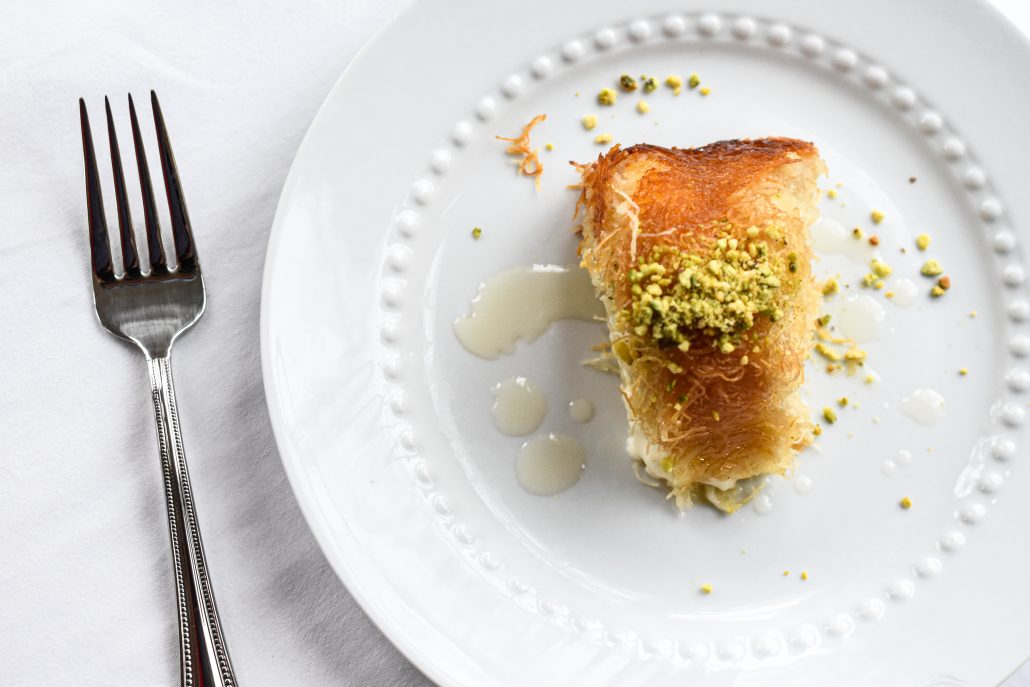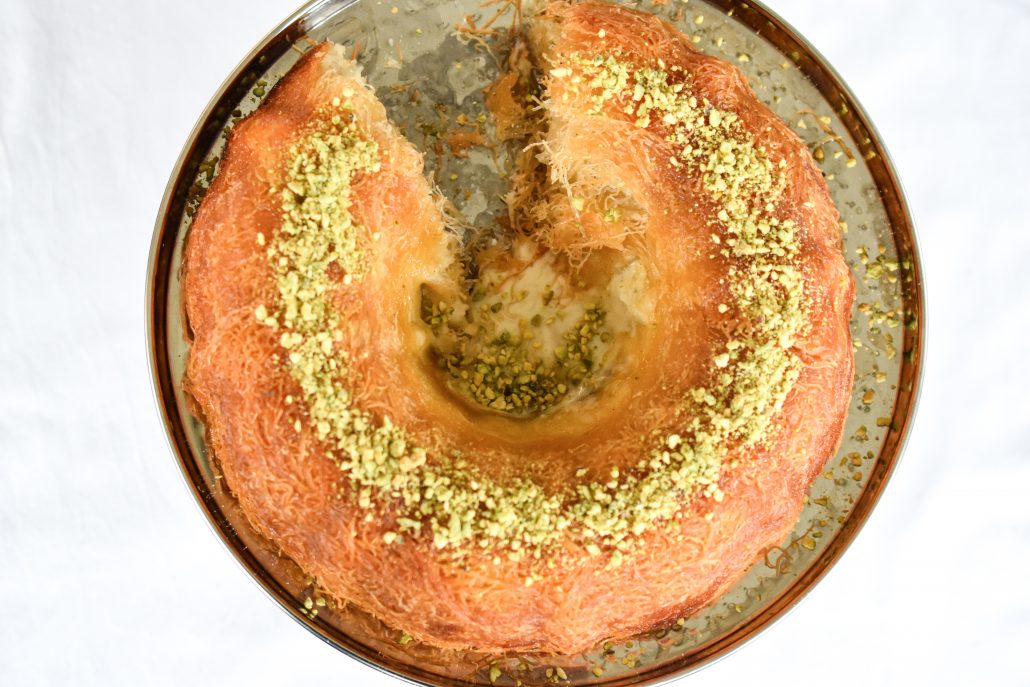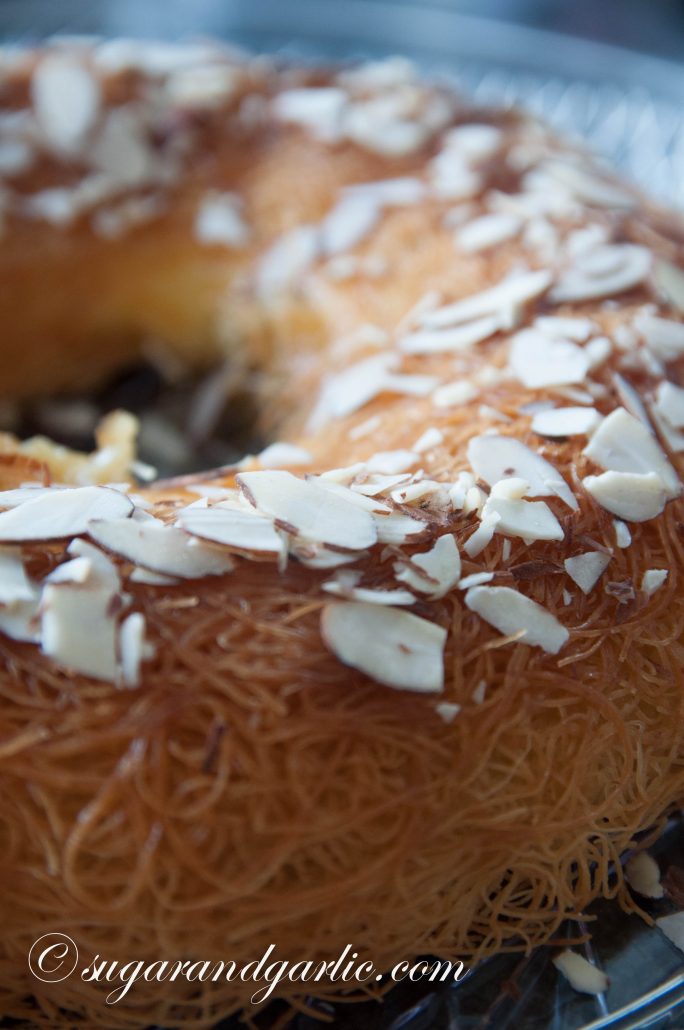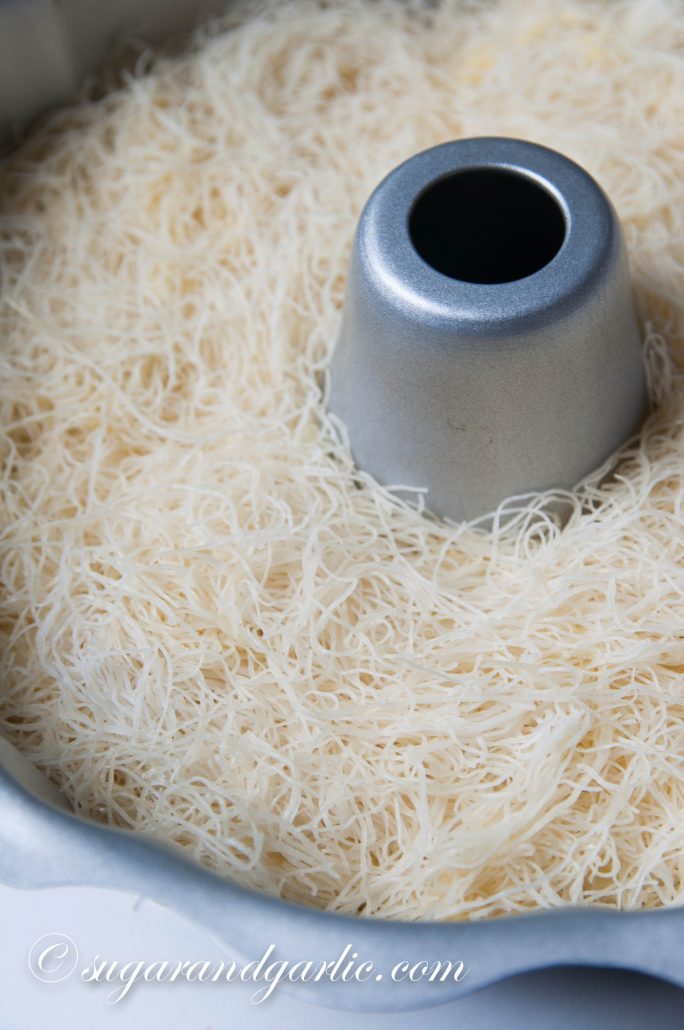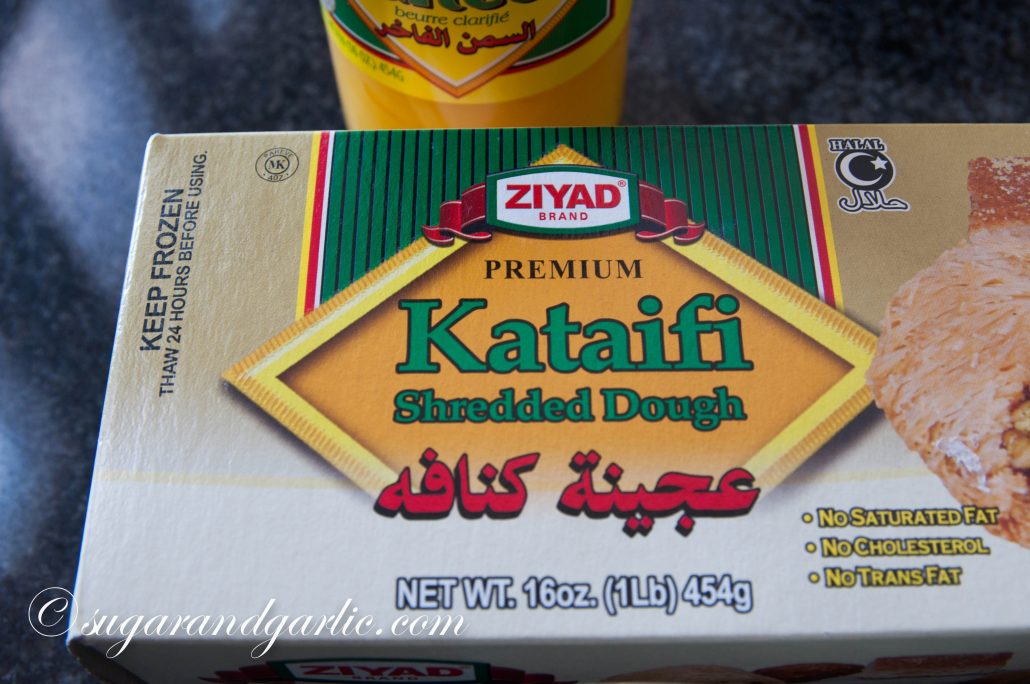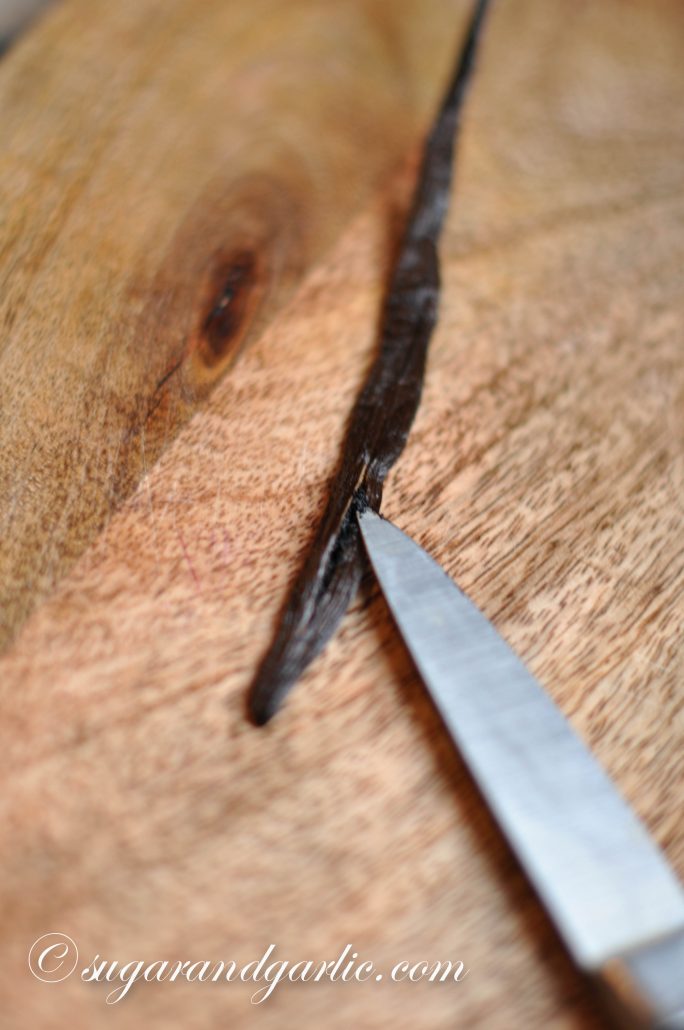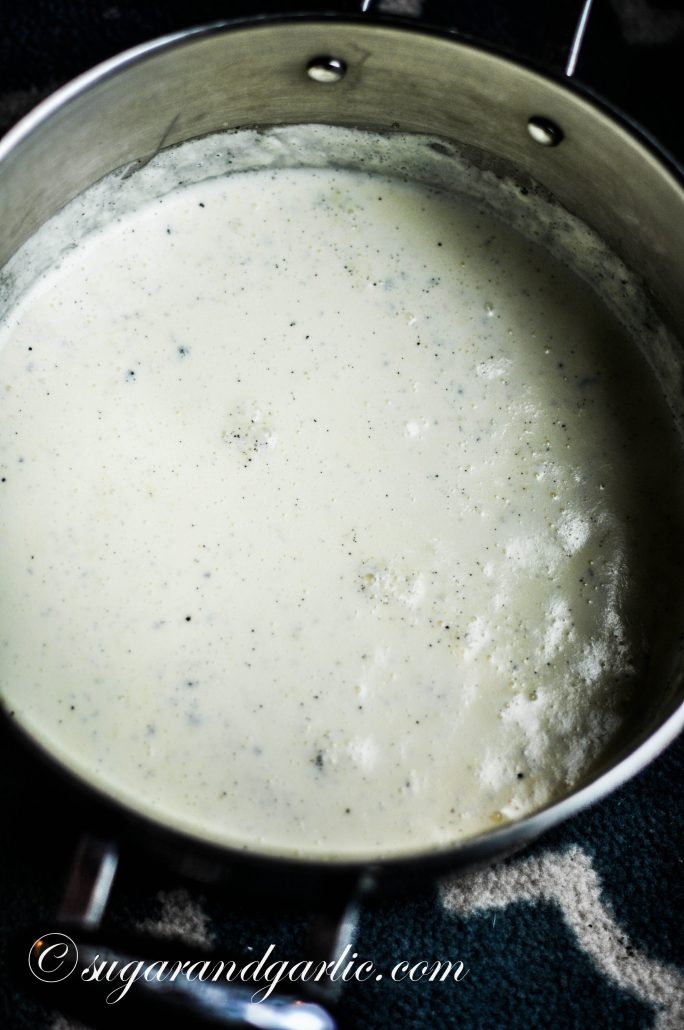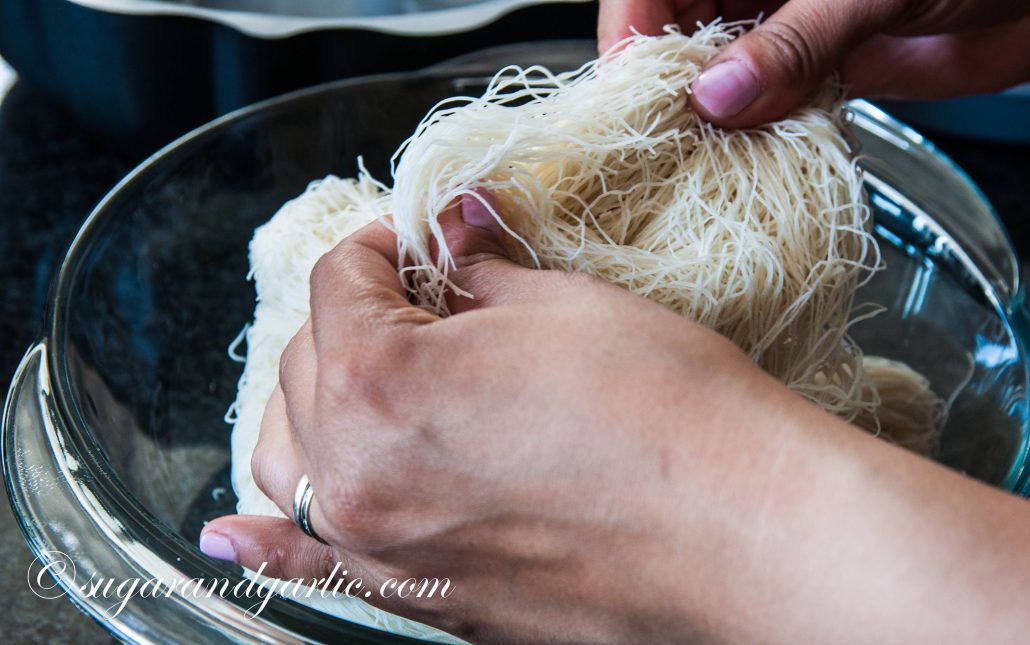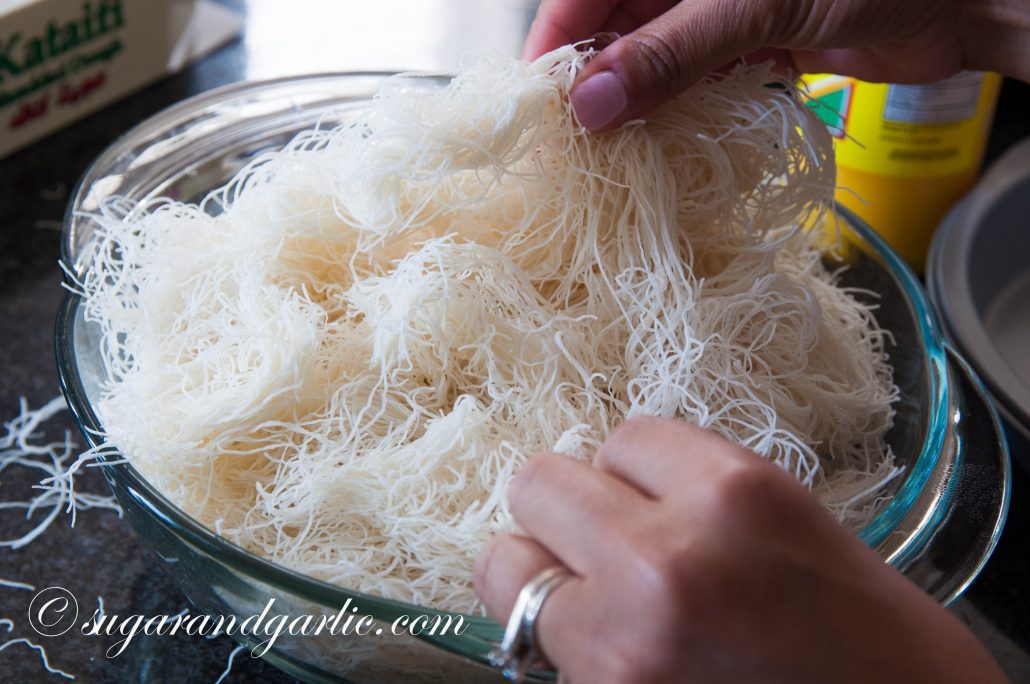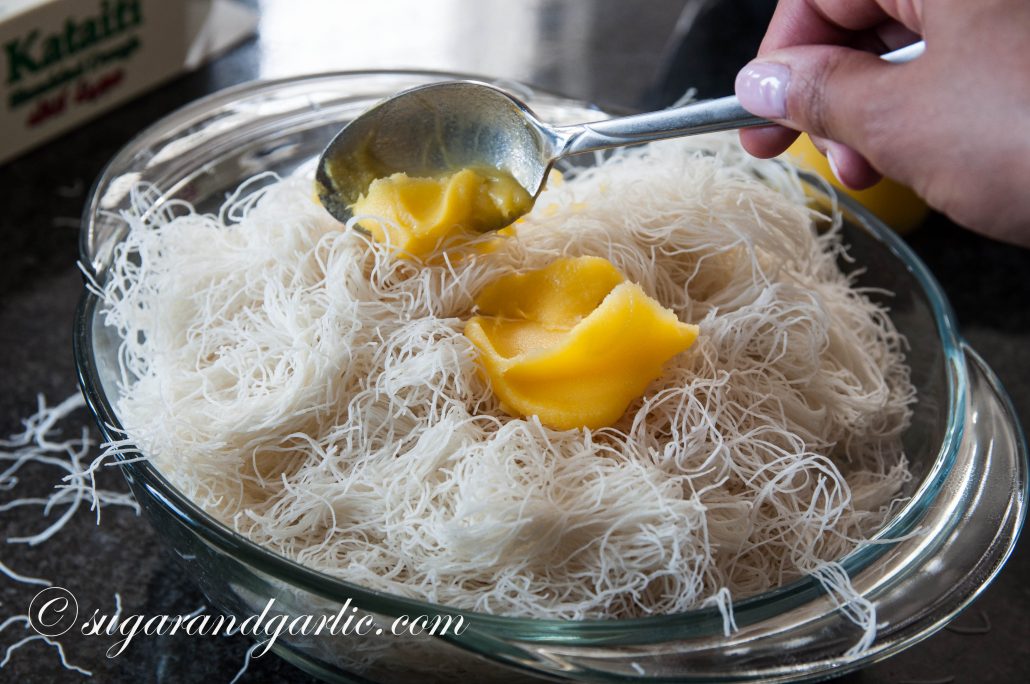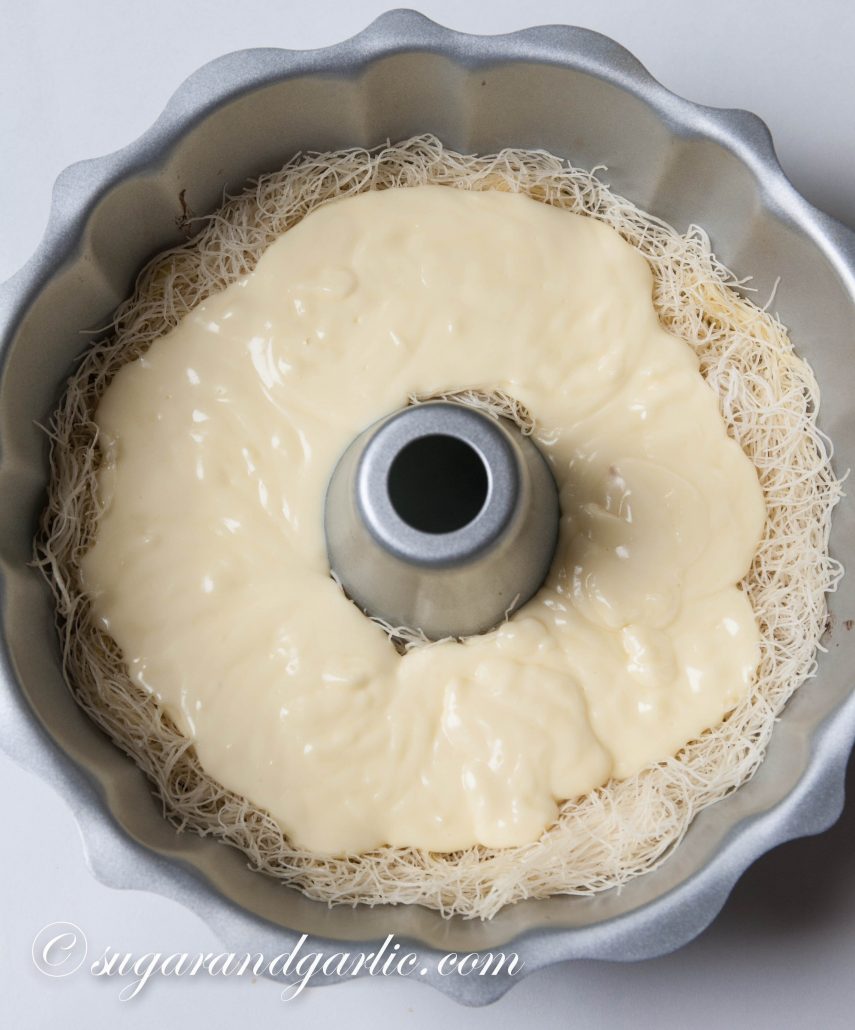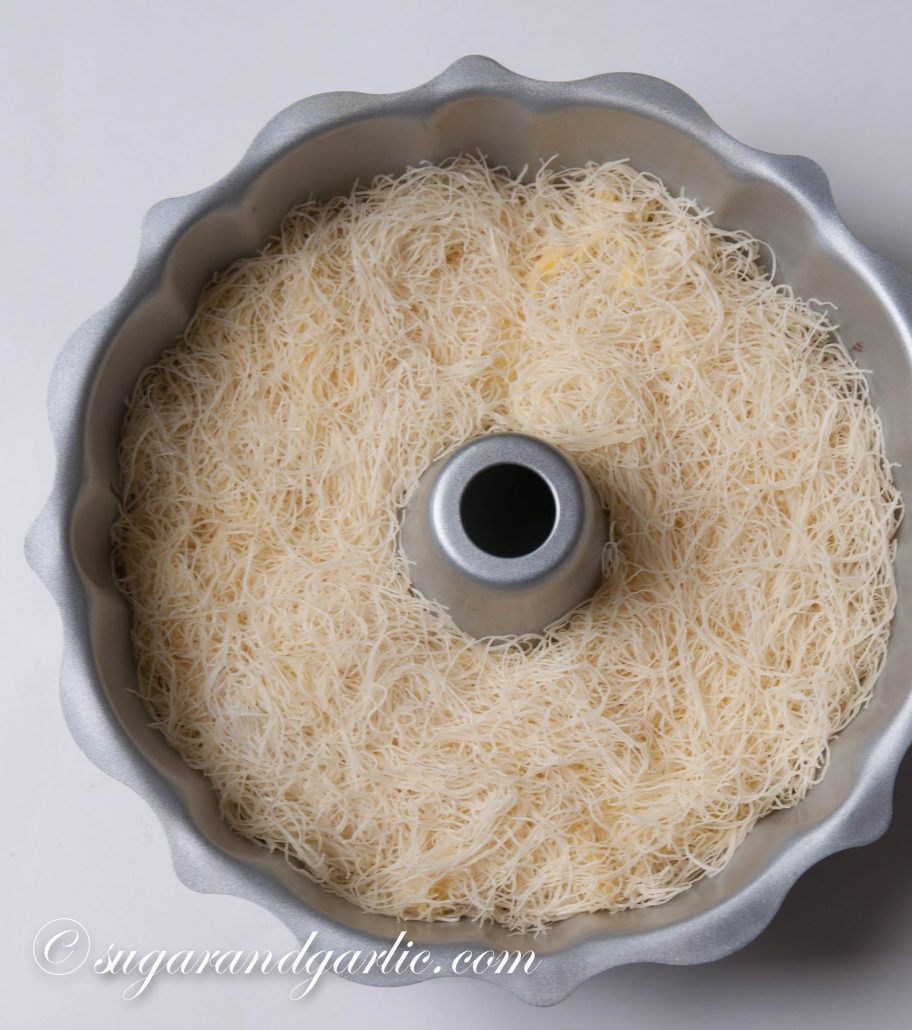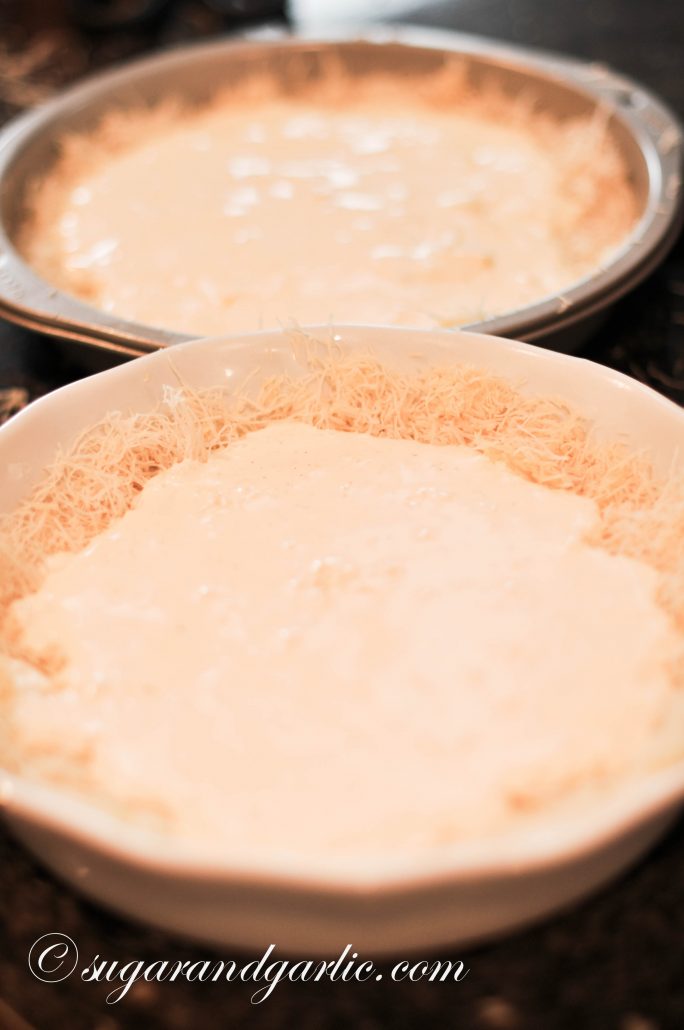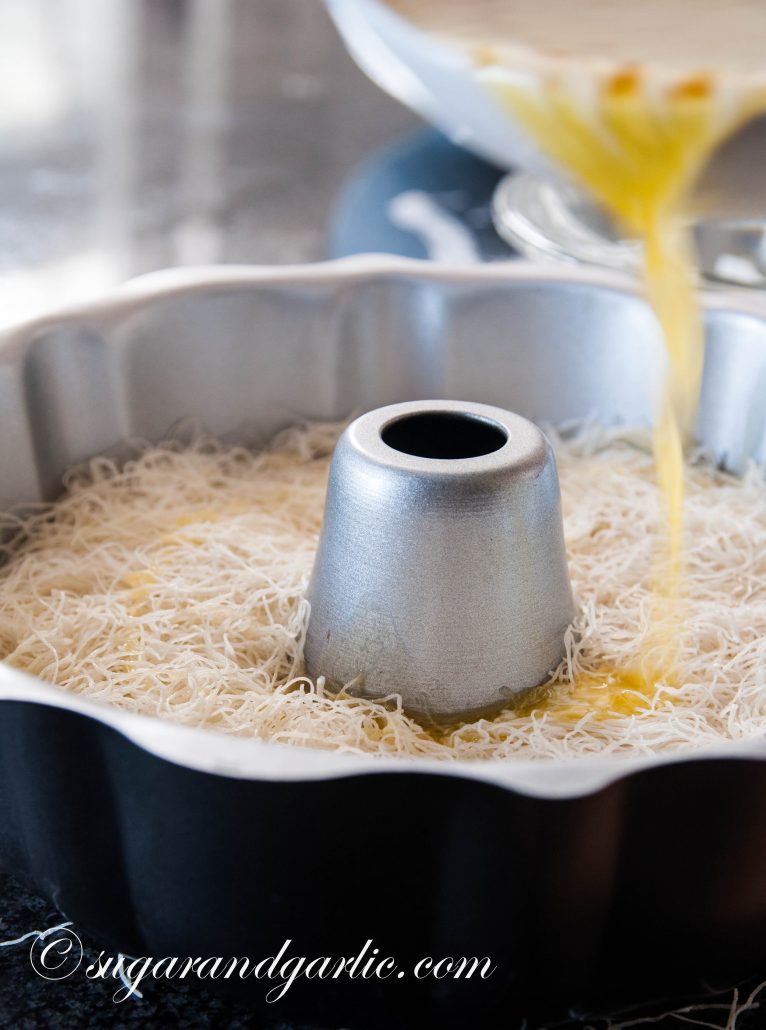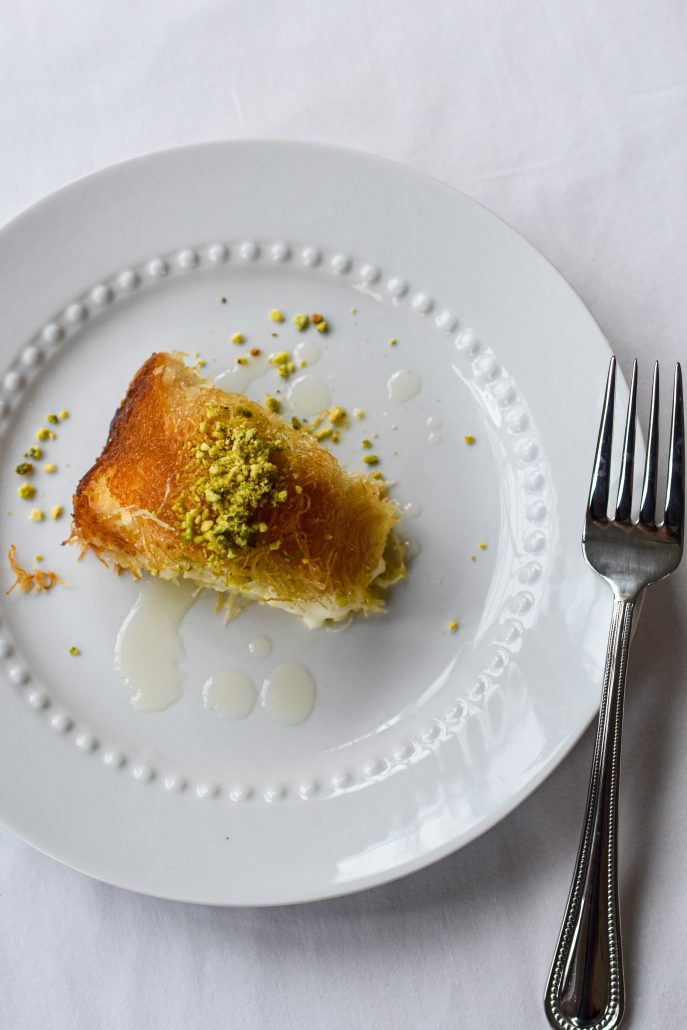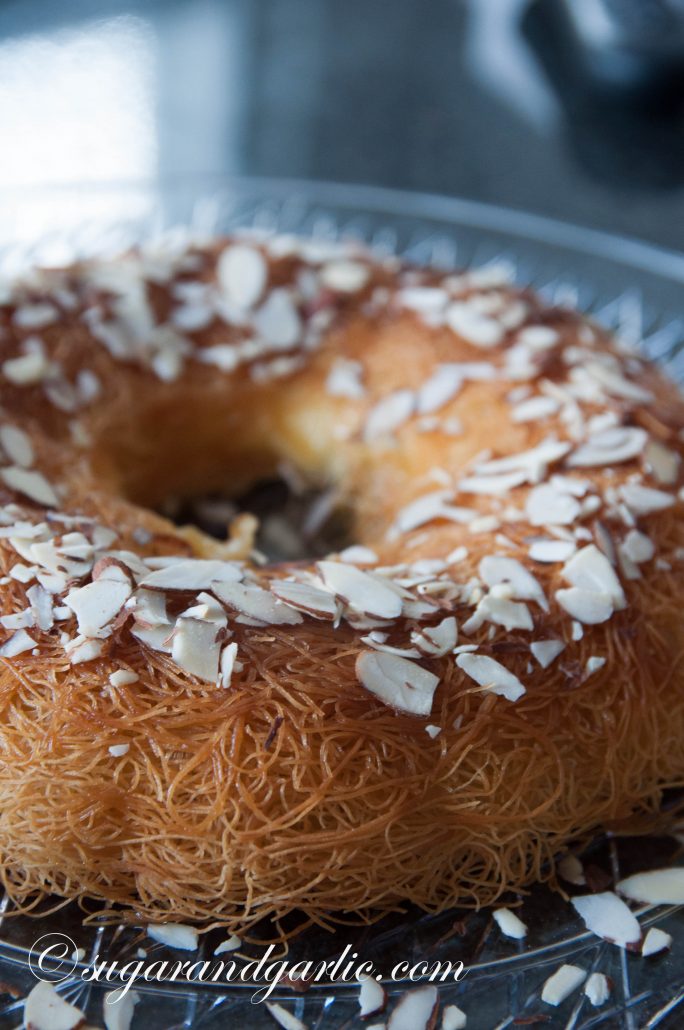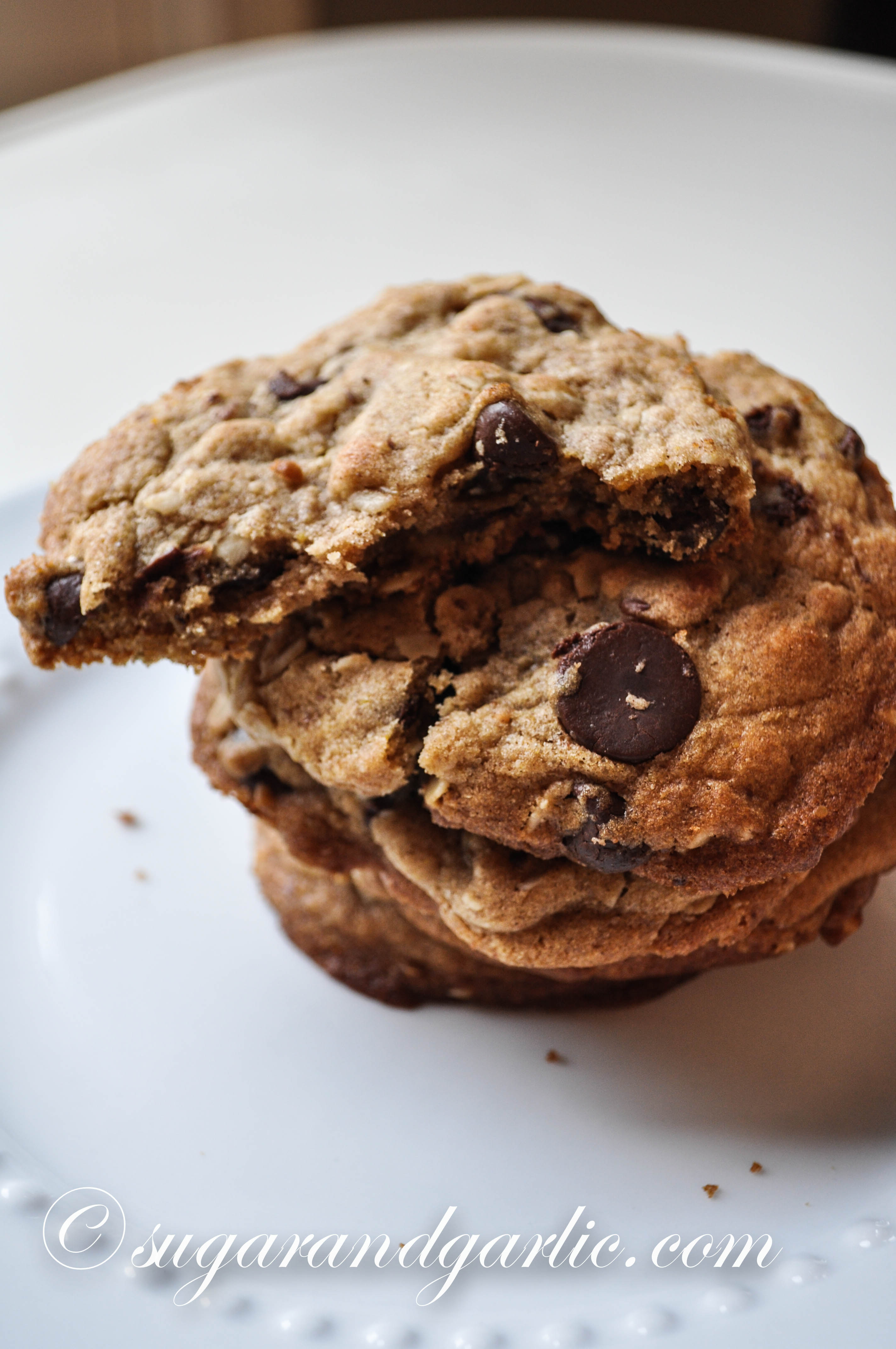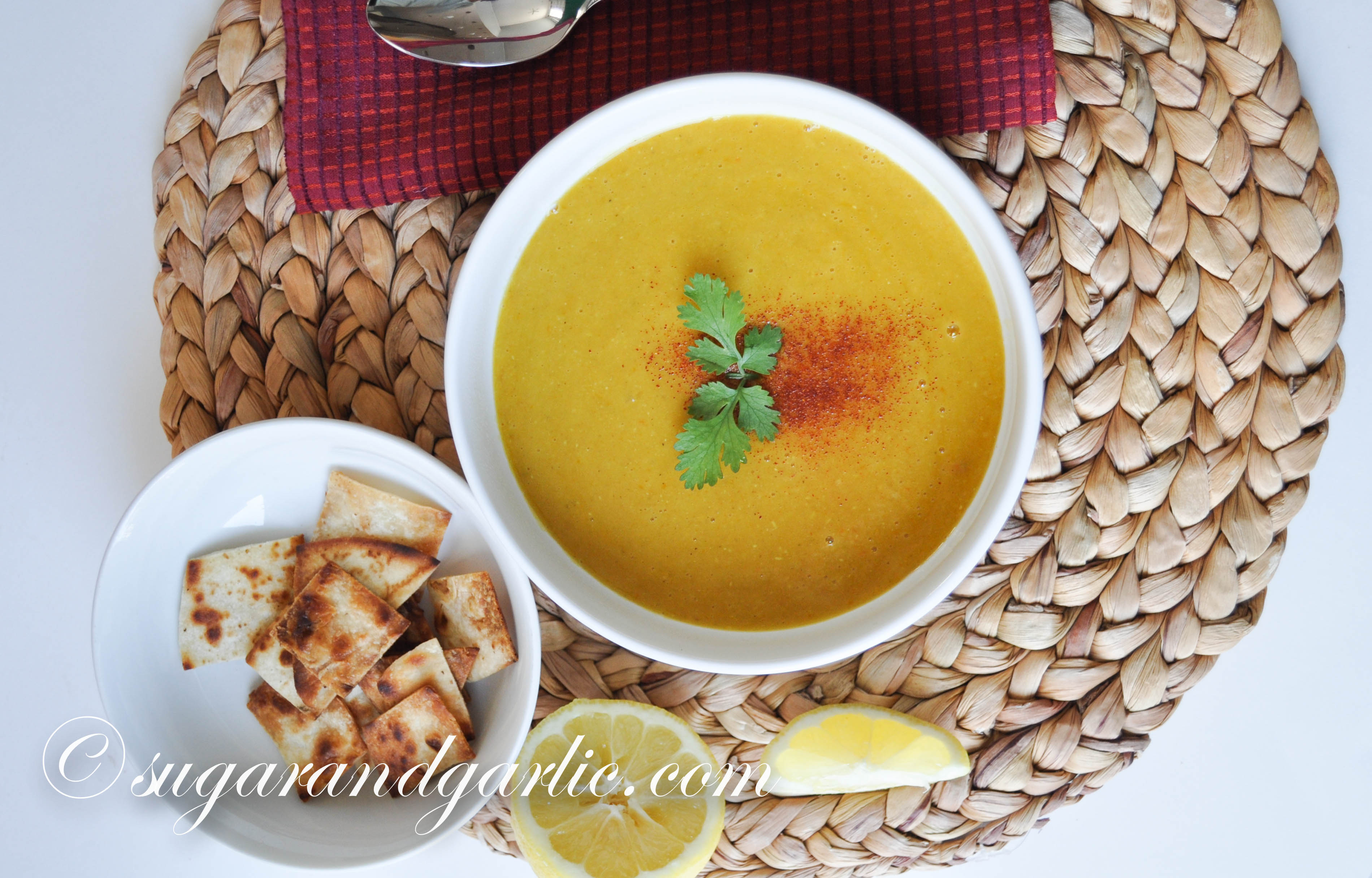Kunafah is a sweet Middle Eastern pastry, made of shredded pastry dough which is drenched in syrup, and filled with a variety of delicious fillings ranging from crunchy cinnamon and sugar coated nuts, a sweet cheese, or a smooth filling of cream (kishta). I have fond memories as a child watching my mother skillfully manipulate the long threads of dough into a beautiful log filled with the crunchy cinnamon and sugar nut and coconut filling. She would then drench it with the simple syrup I often helped her stir in the pot, but until now I still always call her to ask “how much sugar and water? When do I add the lemon?”
A kunafah for everyone
Lately, there is a trend of filling kunafa with all kinds of delicious concoctions such as Nutella, mangoes, coconut cream, cheesecake or whatever else you may fancy. I personally plan to try Nutella out next, following this same recipe but without the vanilla cream. My apple pie kunafah last fall all through Thanksgiving and Christmas was wildly popular! You definitely need to try that out. The flexibility of this easy dessert makes it something anyone can do!
Vanilla bean cream/kishta
This variation is my recipe for a vanilla infused kishta. Kishta is the Arabic word for heavy cream, usually a creamy and decadently smooth filling for pastries. My vanilla bean kishta is an elevated version of a classic pastry cream filled kunafah as is made in Egypt. It is a very basic cream whipped together with cornstarch and milk or cream. Mine is infused with real vanilla bean, which smells heavenly, but you can also use vanilla extract, if you choose. Vanilla bean is a lot more fragrant and impressive though. I conveniently get mine from slofood group, online. You can also find it online from Amazon for speedy delivery:) This is the jar of pure extract paste (and no alcohol) I love to buy for all my baking needs, and I use this in the milk if I don’t have actual vanilla bean pods on hand.
Kunafa is a childhood favorite! Every Ramadan I crave it madly. The unique texture of the shredded phyllo is so delicious and crunchy, and I love the way it absorbs the sweet flavors like a sponge. I always thought this seemingly complicated dessert is only achieved from my mother’s kitchen, or Middle Eastern bakeries.
Lucky for us, this dessert is extremely easy to prepare and make, despite its uniquely complex appearance and textures. I like using a bundt to give it a special shape. You can sprinkle pistachios or almonds on top. I infuse the cream filling with real vanilla bean, and the creamy texture is reminiscent of my all time favorite dessert: creme brûlée.
Ingredients
You will need to purchase kunafah dough at a Middle Eastern market or online. Kataifi dough is almost always purchased in the store, as it is not easy to make at homw. It is called “kataifi shredded dough” in most cases. In Chicago, I go to Sanabel Bakery on Kedzie, which is a wonderful haven to get all kinds of Middle Eastern aromatic spices, herbs, and groceries. The dough is almost always sold frozen. You need to plan to thaw this in the fridge 12-24 hours before you use it. So be sure to get the dough ahead of time. In a pinch, you may leave it on the counter to thaw more quickly and use it the same day, but it must be completely thawed out so that you may work the dough properly. Thawing in a microwave will not work. Do not try it.
Simple Syrup
The first thing to do is to make the simple syrup, known as sharbat in Arabic, so that it has plenty of time to cool. The sharbat is very easy to make; it is sugar mixed with water and a squeeze of lemon juice. Many people add rose water or orange blossom essence to sharbat, but I avoid that overpowering flavor in this recipe to enjoy the main flavor of the vanilla cream in the pastry. Once the water-sugar mixture begins to boil, add a tablespoon of freshly squeezed lemon juice and reduce the heat until it thickens. The syrup needs to cool so that when you pour it onto the hot, freshly baked kunafa, it absorbs quickly, or “drinks” the syrup. Thus the name sharbat which comes from the Arabic root word sharb, meaning drink.
Vanilla infused cream
Next, you will prepare the delicious cream filling. This is my FAVORITE part. Your kitchen will smell amazing. To keep this recipe exactly as I make it, I recommend using either a vanilla bean pod, or vanilla bean paste. Extract powder will work to scent the cream but extract is usually artificial, so the flavor and scent is certainly not the same. I do not recommend using a liquid extract.
When using a vanilla bean, place it against a cutting board and carefully slice open the top along the length of the bean, without puncturing through the bottom. Scrape out all the glorious vanilla bean caviar from the pod with the blunt tip of a butter knife or a small spoon and drop it into simmering cream. The scent is divine, and once you begin to simmer it, the aroma will waft through your home. Simmer 2 cups of heavy cream over medium-low heat and add the vanilla bean. The cream should be speckled with hundreds of beautiful aromatic vanilla bits. I also throw in the whole wooden pod to infuse more flavor, or you could place the emptied wooden pod in a sugar container to have vanilla infused sugar for baking, tea, and coffee. Don’t waste that pod! After simmering for about 5 minutes, you will need to remove the wooden pod and reduce the heat to low to prevent any scorching of the cream. In a separate bowl, stir 2 tbsp of corn starch with cold milk until dissolved, and then pour the corn starch mixture into the cream. Whisk until the cream thickens. Remove from the heat and allow to cool.
The kataifi dough
Now, for the kunafa dough. The thawed dough will most likely be rolled in a thick log of finely shredded pieces; you will need to separate all these pieces with you fingers and begin to chop them into smaller shreds. I cut them down to about 6-8 inch long shreds as I use a bundt pan so the linger pieces form better. In a flat surfaced pan such as a sheet pan or round pan, chopping the shreds even smaller is better. The next step is a great sensory experience for kids: massage the shreds of dough with butter in a large bowl.
The clarified butter
For this pastry, you need to use samnah, which is clarified butter otherwise known as ghee. I love using Kerrygold unsalted butter. It is high quality butter has an amazing flavor and is made from grass fed cow’s milk. This butter makes for more flavorful pastries and it is my go to for baking. Samnah is unsalted butter with all the salt and milk solids removed. It is easy to make. Simply melt unsalted butter and once it is melted, and begins to bubble, remove from the heat and skim off the top when cooled. The salt and solid matter left behind is a delicious treat to lick up with some bread by the way! Samnah could be stored in a container in the fridge and used in many, many other recipes.
Once all of the shredded dough is separated, fluffed out, and massaged with butter, press half of the dough onto the bottom of a circular pan. Pour the cream in the middle and then cover the cream with the remaining buttered kunafa dough. Pour 1/4 c melted butter all over the kunafa and bake uncovered for 25-30 minutes, until golden. Making this in a bundt pan can be trickier to keep the cream in, but it looks so pretty!
As soon as the kunafa is removed from the oven, you need to pour the sharbat all over it to sweeten. After waiting a few minutes (2-3) for the syrup to drip to the bottom of the pan, flip it onto a serving dish, so that the now permanent bottom of the cake gets sweetened as well. Garnish with crushed pistachios or a mixture of nuts as is done traditionally and enjoy! This is often served with a cup of mint or clover tea.
Kunafah bil Kishta
Ingredients
For the syrup:
- 2 c sugar
- 1.5 c water
- 1/4 fresh squeezed lemon juice
For the cream filling:
- 2 tbsp corn starch
- 1/4 c cold milk
- 2 c heavy whipping cream
- 1 tbsp sugar
- 1 vanilla bean pod or 1 tbsp vanilla paste
For the pastry dough crust:
- One box of kunafa shredded dough Prepare by removing the frozen dough from the freezer and thawing in the refrigerator 24 hours before cooking.
- 3/4 cup clarified butter (unsalted butter is fine) soft, not melted
- 3/4 cup melted ghee ( melted unsalted butter is fine)
Instructions
For the samnah (aka ghee) clarified butter:
- This is easier if you make it in advance.
- Melt the butter in a pot.
- Once it boils, turn down the heat. Allow to cool. Scrape off the particles that come to the top and allow to cool until softened. Store in an airtight jar on the counter or in the pantry.
For the Syrup:
- In a large pot, stir the sugar and water and bring to a boil. Once boiling, and the sugar has dissolved, add the lemon juice and reduce to medium-low heat. Allow to simmer until sightly thickened. This step could be done well in advance or even a day prior.
For the cream filling:
- Pour the heavy cream into a small pot and simmer on medium-low heat.
- Slice open the vanilla bean, scrape all the beans out, and drop into the heavy cream. Add the empty pod into the cream. Allow to simmer for about 3-5 minutes. Remove the wooden pod.
- Meanwhile, dissolve the corn starch in the cold milk.
- Turn the heat down to low, and slowly stir in the cornstarch mixture into the cream. Be careful not to let the cream stick to the pot or scorch. Stir until thickened and remove from heat.
For the kunafa crust:
- Loosen and fluff the kunafa dough in a large bowl. Chop the ling strands into shorter pieces with a sharp knife. If you will make this in a large flat pan, it is better to shop the shreds of dough into small pieces to press down by pulsing in a food processor briefly.
- Massage the pastry dough with 1 cup of softened ghee or clarified butter. Rub all the dough until it is all well coated with butter and all loose.
Assembling the dessert:
- Preheat the oven to 350 degrees (F), and move the baking rack to the center.
- Using half the dough, press it into the bottom of a circular pan. Press firmly so that the dough goes up the sides slightly, and there are not any openings or cracks. This will eventually be the top of the kunafa when you flip it, so make sure it is evenly spread.
- Pour the vanilla cream all over the bottom layer.
- Carefully place the remainder of the buttered kunafa dough over the cream, making sure all the cream is covered all the way to the edges, without pressing the cream to ooze out. Make sure you gently pat down any of the shreds down so they are not sticking up, or they will scorch in the oven.
- Pour the melted butter evenly over the entire pan to soak it in butter.
- Bake in the oven for 25-30 minutes until the top is golden.
- As soon as the kunafa is removed from the oven, pour the cooled syrup all over, evenly. You might not need all of it. After about 20 minutes, flip the kunafa onto a serving platter, leaving the pan over it for a minute. This is important to ensure the syrup goes to the bottom of pastry after flipping, so that is is not dry on the bottom.
- Garnish with crushed pistachios
